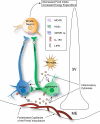Pathophysiology and treatment of inflammatory anorexia in chronic disease
- PMID: 21475703
- PMCID: PMC3060655
- DOI: 10.1007/s13539-010-0015-1
Pathophysiology and treatment of inflammatory anorexia in chronic disease
Abstract
Decreased appetite and involuntary weight loss are common occurrences in chronic disease and have a negative impact on both quality of life and eventual mortality. Weight loss in chronic disease comes from both fat and lean mass, and is known as cachexia. Both alterations in appetite and body weight loss occur in a wide variety of diseases, including cancer, heart failure, renal failure, chronic obstructive pulmonary disease and HIV. An increase in circulating inflammatory cytokines has been implicated as a uniting pathogenic mechanism of cachexia and associated anorexia. One of the targets of inflammatory mediators is the central nervous system, and in particular feeding centers in the hypothalamus located in the ventral diencephalon. Current research has begun to elucidate the mechanisms by which inflammation reaches the hypothalamus, and the neural substrates underlying inflammatory anorexia. Research into these neural mechanisms has suggested new therapeutic possibilities, which have produced promising results in preclinical and clinical trials. This review will discuss inflammatory signaling in the hypothalamus that mediates anorexia, and the opportunities for therapeutic intervention that these mechanisms present.
Figures

References
-
- Evans WJ, Morley JE, Argilés J, Bales C, Baracos V, Guttridge D, Jatoi A, Kalantar-Zadeh K, Lochs H, Mantovani G, Marks D, Mitch WE, Muscaritoli M, Najand A, Ponikowski P, Rossi Fanelli F, Schambelan M, Schols A, Schuster M, Thomas D, Wolfe R, Anker SD. Cachexia: a new definition. Clin Nutr. 2008;27:793–799. doi: 10.1016/j.clnu.2008.06.013. - DOI - PubMed
Grants and funding
LinkOut - more resources
Full Text Sources

